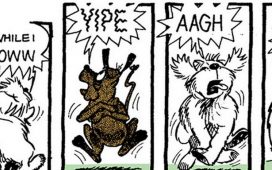In the example clues below, I explain the two parts of each: the definition of the answer, given in bold type and the wordplay – the recipe for assembling its letters. In a genuine puzzle environment, of course, you also have the crossing letters, which greatly alleviate your solving load. The explanations contain links to previous entries in this series on such matters as spelling one word backwards to reveal another. And setters’ names tend to link to interviews, in case you feel like getting to know these people better.
How does it work?
Each crossword clue is a piece of language that often has nothing to do with the answer. It might depict a little scene, or sound like someone’s telling you something.
Sometimes (not very often) it tells you that someone stutters. Here’s a recent clue from Vulcan:
2ac A c-competitor is coming (7)
[ wordplay: a (‘A’) + synonym for ‘competitor’ with first letter repeated ]
[ A + RRIVAL ]
[ definition: coming ]
So instead of “competitor” indicating “rival” as it normally might, we have the clue’s “c-competitor” indicating that there’s RRIVAL in the answer, ARRIVAL. Not that you pronounce the word “a-ruh-rival”; it’s only a stutter in the way you initially read the clue.
Likewise, here’s Dante in the Financial Times, the paper that seems the most fond of the stammer, with a clue …
7d Publish and I p-prosecute (5)
[ wordplay: I (‘I’) + synonym for ‘prosecute’ with first letter repeated ]
[ I + SSUE ]
[ definition: publish ]
… for ISSUE.
It’s not always that simple
If you’re wondering whether crossword setters, being devious, might sometimes use “p-prosecute” to indicate PSUE rather than SSUE … well, I’ve seen it happen. More often, the stammer may be combined with another cryptic device.
Here’s one from the Observer’s series for beginners, Everyman, which asks you to put one part of the wordplay inside another …
11ac Odd, Eric pinching c-coin of little value (9)
[ wordplay: ERIC containing (‘pinching’) coin of little value with first letter repeated ]
[ ERIC containing CCENT ]
[ definition: odd ]
… for the answer, ECCENTRIC.
Other times, the solver might tell you that there is a stammer, rather than spelling it out, as with Bradman …
19d Report from a noble fellow with a stutter (7)
[ wordplay: A (‘a’) + type of ‘noble fellow’ with first letter repeated ]
[ A + CCOUNT ]
[ definition: report ]
… in a clue for ACCOUNT.
Screw takes a different approach again …
4d Daisy sounded out by stutterer in tree (5)
[ wordplay: how someone with a stutter might pronounce name of animal that might be called Daisy ]
[ definition: tree ]
… in this twist on the soundalike kind of clue, where we imagine someone stuttering the word “cow” and making a sound like CACAO.
And how to enjoy them
Quite honestly, not everyone does. Stuttering clues are, I understand, forbidden in some papers. Some solvers worry that fun is being had at the expense of the imaginary stammerer, reminiscent perhaps of Arkwright in Open All Hours.
Others suspect that an arbitrary stutter is close to cheating: a way for the setter to indicate some pesky letter without having to work very hard. I’m not so sure. Azed – Everyman’s clever older brother in the Observer – is partial to the occasional stutter and no one could accuse him of slacking. Perhaps the word “occasional” is key.
Over to you
Beginners: any questions? Setters and seasoned solvers: any favourites? I’m quite fond of this Everyman clue, where you don’t even need to find a synonym of the stuttered word …
… to get to the answer, STAMMER.













